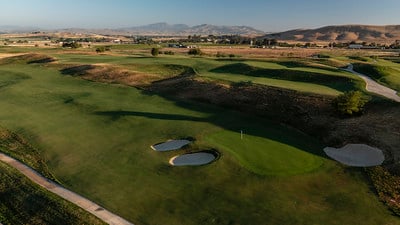Poppy Ridge: The Inside Scoop--Architect Jay Blasi Talks THE VISION (Clone)
May 29, 2025 / by Jerry Stewart

Legendary golf course architect Alister MacKenzie’s design philosophy was that a course should be interesting, stimulating, and enjoyable for all levels of players while blending in with the natural landscape.
It’s those tenets that fueled modern-day architect Jay Blasi in the design of the all-new 18-hole course at Poppy Ridge Golf Course.
From Chambers Bay (where he was a design associate under Robert Trent Jones II) that held numerous significant championships, including the U.S. Open and the U.S. Amateur, through to SentryWorld that held the U.S. Senior Open, Blasi’s vision and artistic flair has helped shaped some of the best-known golf courses in the world.
And now he has brought those components to Poppy Ridge.
We recently caught up with Blasi to have him talk about his vision at Poppy Ridge and how he was able to transform and elevate the existing property.
What did you envision when you originally saw the land/canvas that you would be using?
I was very attracted to the property at Poppy Ridge. The land is open and rolling and dotted with oak trees and has a very big scale to it. There is over 200 feet in elevation change and there are long views of the nearby vineyards, ranchland and mountains. Seeing how special the land was, it was my goal to try and craft a golf course that took advantage of the best parts of the property, while matching the scale of the site and ensuring it feels very natural.
How much of your design process revolved around the site being the home course for NCGA members?
From the very first discussion about the course transformation, it was imperative that the new course be a wonderful home for all NCGA members. One that would challenge the best while also being enjoyable for players of all abilities. To me that was one of the exciting and challenging aspects of the project. It isn’t every day that you get the opportunity to work on a facility that is catered to players of all abilities but also capable of challenging the best players via NCGA championships. Designing for all players—be it a beginner or scratch championship player-- was central to every decision we made throughout the process.
Can you describe the design process you utilized to ensure that the course is challenging for the most advanced players while also being fun for players of all abilities?
While challenging the best and being playable for all golfers sounds counterintuitive the reality is that championship golf and everyday golf are two drastically different games. Luckily, what makes a course challenging for the best players is almost the opposite of what makes it challenging for the everyday player. A good example would be an approach shot to a par-4. If a green is surrounded by deep bunkers and rough, that is a scary and challenging sight for everyday golfers. They aren’t good out of bunkers or rough, and executing a lofted shot is tough. On the other hand, that same approach is not that scary or challenging for the best players because they’re capable of executing that shot and recoveries from sand or rough are simple sand wedge shots for them. What is harder for a top player to navigate is a green with fairway around it and some contours that feed the ball one way or another. Then the top players need to think about where they want the ball to land, how they want to get the ball there, what will happen once the ball lands and more. If they miss the green, then they have to decide what type of shot to hit and what club to use--where every club in the bag is an option. That is much harder for a top player because they need to think and execute, but that type of approach and recovery are much more inviting and fun for the everyday golfer.
What excited you the most about the landscape at Poppy Ridge?
I fell in love with the big, bold rolling landscape and the long views at Poppy Ridge. The challenge was to highlight that big, bold landscape but to do so in a way that was playable and more walkable.
What was a challenge in the design process?
There were two real challenges for the project. The first was making the course feel natural when the old golf course had a lot of man-made features (lakes, mounding, bunkers) and we were going to have full-length concrete paths. The second was just the logistics of construction. We needed to erase an old golf course, build the new one and get it done in a matter of months so we could get the grass down in our desired window.
VIEW PHOTO GALLERY BELOW
